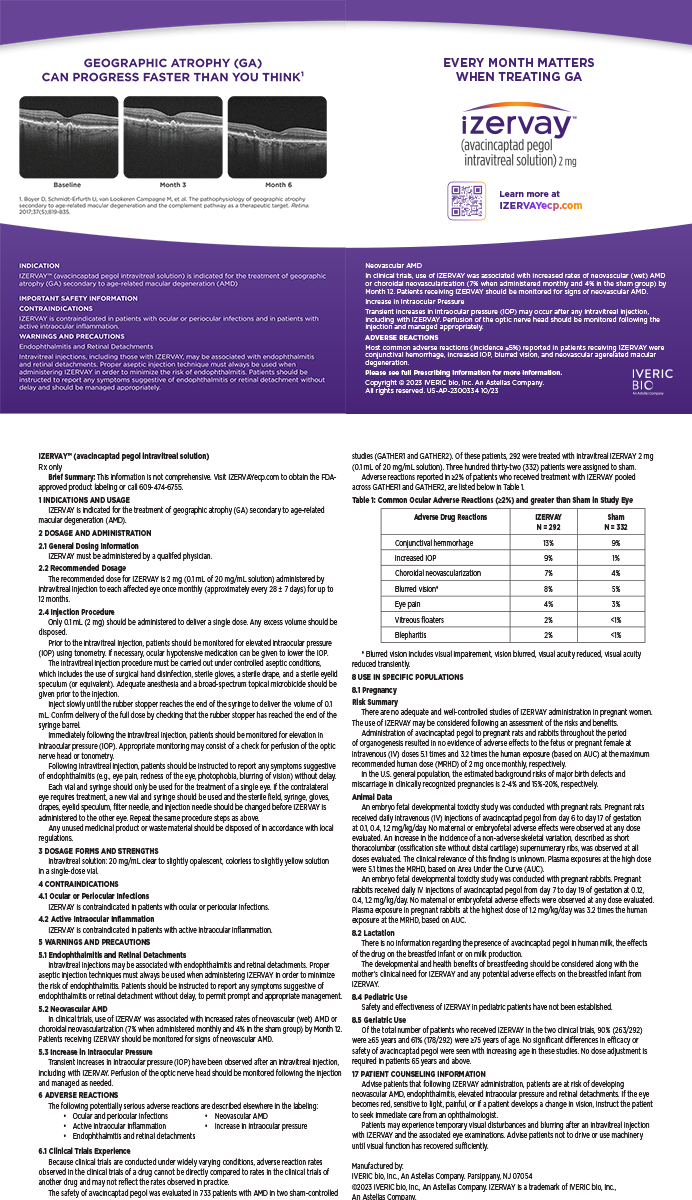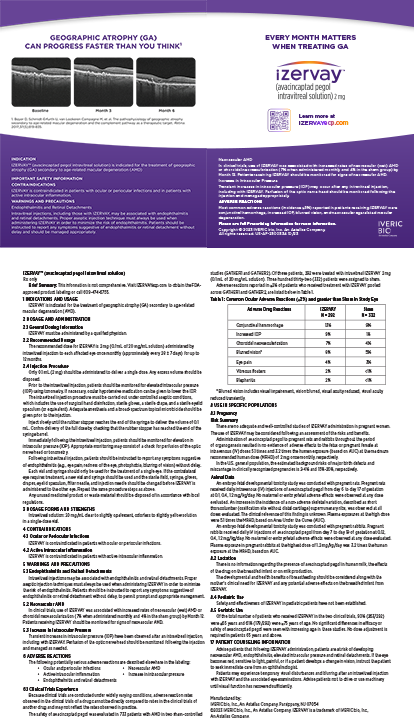CASE PRESENTATION
A 59-year-old man initially presented for ongoing management of his well-controlled, bilateral, primary open-angle glaucoma. The patient's UCVA was 20/50 OD and 20/30 OS. He was instilling timolol (Timoptic; Aton Pharma) twice daily and latanoprost (Xalatan; Pfizer) at bedtime in both eyes. He had received bilateral cataract extraction 10 years earlier. Additionally, his right eye had undergone eight-cut radial keratotomy (RK) after cataract extraction to correct a residual refractive error.
The patient returned 3 months later with sudden vision loss in his right eye. The visual acuity in that eye was count fingers at 2 feet, and the slit-lamp examination was remarkable for dislocation of the lens-bag complex into the vitreous cavity. The surgeon repositioned the rigid 7-mm PMMA IOL by cleaning off the capsular components intraocularly and then securing the haptics via intrascleral fixation. Immediately postoperatively, the patient's refraction was +5.00 D.
One year after surgery, he has +2.00 D of residual hyperopia and a UCVA of 20/200 that corrects to 20/40 with +2.00 D in his right eye. What is the best option for this very unhappy patient? His preoperative manual keratometry (K) readings were 35.50@35/37.25 (Figures 1 and 2).
—Case prepared by Charles Cole, MD. 

ARUN C. GULANI, MD
I would apply the principles of corneoplastique.1 Why is this patient's visual acuity not 20/20 on refraction? The first step is always to determine best vision potential, so I would conduct a trial of hard contact lenses with overrefraction to determine if the patient has any potential beyond 20/40. If not, then he would undergo a retinal evaluation for maculopathy. If the retina is normal and refraction still does not achieve a visual acuity better than 20/40, the improvement from 20/200 to 20/40 is still exciting (and functional) enough that I would want to do something for this patient.
The surgeon in this case did a nice job in terms of the patient's spherical refractive error. Because refraction translates to vision, advanced laser surface ablation is an option. Assuming the internal anatomy is now stable, I would perform advanced laser surface ablation in PRK mode and apply mitomycin C 0.02% for 20 seconds.
I would like information on the patient's other eye, specifically on his reading vision. If his right eye is not dominant, I would aim for -0.75 D sphere. Not only would he appreciate binocularity (the other eye being good for distance), but he would also be able to read—especially coming from hyperopia, which is frustrating at his age. This approach would also limit RK fluctuations (if any) to within emmetropia and myopia along with higher keratometry.2,3
Corneal collagen cross-linking (not FDA approved) could be used to make this endpoint permanent, but in my experience, it is not usually needed. I would expect the patient to be very pleased.
AYLIN KILIÇ, MD
RK can permanently alter the corneal epithelium and endothelium. The procedure scars the stroma and demonstrably weakens the eye wall's resistance to trauma. RK incisions will swell during even the gentlest intraocular surgery, which can induce corneal flattening and result in excessive hyperopia immediately postoperatively. For instance, a 39.00 D cornea may flatten to 35.00 or 34.00 D at an incision. Then, after a few weeks or a few months, as the incisions gradually retighten, the cornea returns to what it was. These changes are a big deal. With a plano target, the patient may be hyperopic early postoperatively but myopic a few months or a year later.
I would fit this patient with a rigid gas permeable contact lens. If his visual capacity increased by no more than 2 lines, I would recommend transepithelial topography-guided treatment. Before this procedure, it is important to warn patients that previous surgeries can cause midterm refractive instability, which may require further corneal transplantation. If the patient's visual capacity increased by more than 2 lines with a rigid gas permeable contact lens, I would recommend deep anterior lamellar keratoplasty.
Corneal collagen cross-linking may decrease fluctuations in and the instability of vision in patients such as this one. No studies, however, have shown that the procedure can change the hyperopic shift.
ERIK L. MERTENS, MD, FEBO
One possible approach would be to correct the patient's residual hyperopia with IOLs. The problems here with a lens placed in front of the iris such as the Artisan (Ophtec) are the incision larger than 5 mm and the obligatory sutures to close that incision. Unfortunately, the small-incision Artiflex (Ophtec; not FDA approved) is not available in hyperopic powers. A posterior chamber IOL such as the Sulcoflex (Rayner) and the four-haptic AddOn (1stQ; not FDA approved) would be in close contact with the intrasclerally fixated PMMA lens and could exert extra stress and strain, compromising the stability of the two IOLs. Another candidate is the Visian ICL (STAAR Surgical), which generally sits in the ciliary sulcus. In this situation, the overall stability of the intrasclerally fixated PMMA lens would need to be guaranteed, which would be nearly impossible.
I would therefore propose wavefront-guided PRK4 with intraoperative mitomycin C 0.02%. LASIK would not be my preference in this case because of the risk of opening up RK incisions and the potentially negative and unpredictable effects of the suction on intrascleral fixation and the flap's integrity. n
Section Editor Lisa Brothers Arbisser, MD
• emeritus position at Eye Surgeons Associates, the Iowa and Illinois Quad Cities
• adjunct associate professor, John A. Moran Eye Center, University of Utah, Salt Lake City
Section Editor Tal Raviv, MD
• founder and director, Eye Center of New York
• clinical associate professor of ophthalmology, New York Eye and Ear Infirmary of Mount Sinai
• (212) 889-3550; talraviv@eyecenterofny.com
Section Editor Audrey R. Talley Rostov, MD
• private practice with Northwest Eye Surgeons, Seattle
Arun C. Gulani, MD
• director, Gulani Vision Institute, Jacksonville, Florida
• (904) 296-7393; gulanivision@gulani.com
Aylin Kiliç, MD
• practices at Dunya Eye Hospital, Istanbul, Turkey
• +90 212 3623232; aylinkilicdr@gmail.com
Erik L. Mertens, MD, FEBO
• medical director, Medipolis, Antwerp, Belgium
• chief medical editor, CRST Europe
• +32 3 8282949; e.mertens@medipolis.be
• financial disclosure: consultant to STAAR Surgical
1. Gulani AC. Corneoplastique: art of vision surgery. Ind J Ophthalmol. 2014;62:3-11.
2. Gulani AC. Shaping the future and reshaping the past: the art of vision surgery. In: Copeland and Afshari's Principles and Practice of Cornea. New Delhi, India: Jaypee Brothers Medical Publishers; 2013:1252-1273.
3. Gulani A. Correcting radial keratotomy: refractive “epidemic” of future? Ophthalmology Times. 2014;39(16):6-10.
4. Ghanem RC, Ghanem VC, Ghanem EA, Kara-José N. Corneal wavefront-guided photorefractive keratectomy with mitomycin-C for hyperopia after radial keratotomy: two-year follow-up. J Cataract Refract Surg. 2012:38(4):595-606.


